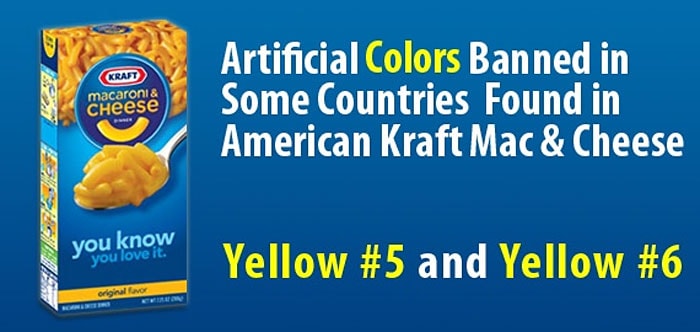
Written By: Christina Newberry
Reviewed By: Gloria Tsang, RD
Title: Registered Dietitian
Last Updated on:


You may recently have heard about people protesting Kraft’s use of artificial colors in its Mac & Cheese noodles. Wondering why people are so upset – and whether you should be concerned? Let’s take a look at what’s really in those cheesy noodles, and how the U.S. version differs from the version sold in the UK.
Table of Contents
First, a bit of background about the two artificial dyes that are the subject of the petition.
Yellow #5 (also called tartrazine) and yellow #6 are both banned in Norway. While they are not technically banned in the UK and Europe, manufacturers were asked to start phasing them out voluntarily in 2008. What’s really moved the removal of these food dyes forward is that products containing these dyes in Europe now carry a warning label saying “consumption may have an adverse effect on activity and attention in children.” That would certainly make most consumers think twice about buying a product containing one of these yellow dyes!
We on HealthCastle.com first revealed about these yellow dyes in our Easter chocolate egg candy review back in 2010.
Here at home, the U.S. Center for Science in the Public Interest called for a ban on these dyes in food products back in 2010, but saw no results.
Why the move to phase out these colors? Well, as the European warning suggests, they have been linked to hyperactivity in children. They are also known allergens, with those who are allergic suffering everything from hives to migraines.
There’s also the plain fact that these colors are made from coal tar. Gross!
In March, two food bloggers – Vani Hari and Lisa Leake – started a petition on Change.org asking Kraft to remove the artificial colors yellow #5 and yellow #6 from its Mac & Cheese after they discovered that Kraft does not use these dyes in its macaroni and cheese product (called Cheesey Pasta) in the UK. Kraft’s UK Cheesey Pasta product uses paprika extract and beta-carotene to color the product instead.
They argue that if Kraft can reformulate its product to remove artificial dyes for the European market, it should be able to offer that same version at home. The petition has been signed by more than 280,000 people. Earlier this month, Hari got a meeting with Kraft executives, but so far the company seems unmoved by the uproar. They suggest customers who want to avoid the artificial dyes buy another versions within their product line that does not contain the coloring, such as the White Cheddar variety.
Canadian readers, lest you think your Kraft Dinner is exempt from this issue, take note: It contains tartrazine, too.
Yellow #5 and yellow #6 are used in many processed food products across North America – just one more reason to avoid highly processed foods. If you want to avoid artificial colors in your macaroni and cheese, look for white or organic varieties, or better yet, make your own.
Alumni: University of Victoria – Christina Newberry is a writer and editor whose work has appeared in national and local magazines and newspapers. With a Bachelor’s degree in English and Anthropology from the University of Victoria and a Journalism Certificate from Langara College, Christina brings keen curiosity and the love of a good story to her work with HealthCastle.com.
Christina is a passionate traveler and urban gardener with an interest in vegetarian eating and making good, tasty food from scratch. Sharing lessons learned from her own experiences, Christina writes about lifestyle topics for HealthCastle, with a focus on eating well at home and on the road.
artificial colors, grocery aisle, home cooking, world